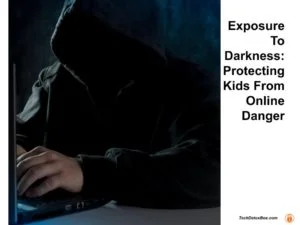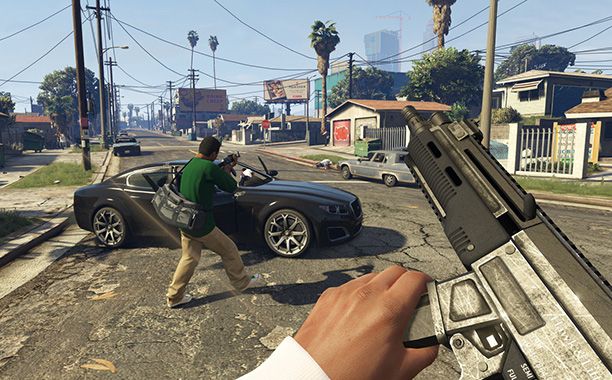
Exposure to Darkness: Protecting Kids from Online Danger
How young is too young to lose the innocence of childhood?
To discover that the world could be an ugly and dangerous place?
When our 10-year old daughter got an iPad for her birthday, we were excited to check out her favorite cat videos on YouTube together. We turned on the iPad, opened Safari browser, and I typed the letter Y in the address box. Autosuggestion filled out the rest. The site that it offered to my innocent child was Youporn – not YouTube.
Open Internet is like that. Exposure to darkness can happen when we least expect it.
Cat videos had to wait. I spent hours setting up content filters before we tried again.
Pornography
27% of all online videos are pornographic. More than a quarter of the Internet. Are we naïve enough to assume our children will not see it? My son came across inappropriate content accidentally. But then he got curious and looked for more. Thankfully, he had the wisdom to tell me and I scrambled to update content filters on our family WiFi. Many kids never tell, and pornography proceeds to destroy their brains, leading to porn addiction and sexual dysfunction in adulthood.
Childhood 2.0 documentary shows that 70% of tweens and 84% of teens have been exposed to sexual content.
Average age of first exposure is 11.
Shocking, but true. My daughter told me another story: kids on her school bus were making “unholy noises”, and when she asked them to stop, only did it more to irritate her. “Unholy noises? What kind of noises would that be?” – I asked innocently. She had to explain to her oblivious mother.
“Unholy noises” are the sound effects kids learned from Internet porn.
Kids are curious about sex, which is developmentally normal. But instead of healthy sexual education from their families and schools, they are getting all the wrong ideas from XXX websites. It’s not their fault: porn hijacks powerful instincts that respond automatically – like fight of flight. The makers of the “product” know exactly which buttons to push in the subconscious. Hormonal forces take over, and the rational mind is too weak to stop them – the prefrontal cortex, responsible for impulse control, is not developed until the age of 25. To make matters worse, the rational and the emotional do not communicate well until the brain is fully formed.
Grown men struggle with pornography – a child’s brain does not stand a chance.
They will look – even when they know it’s wrong.
Predators
“Stranger danger” in the digital age is in the privacy of a child’s bedroom, when they are alone with their devices. The more time they spend on screens – unsupervised – the higher the chances they could become a target of sexual exploitation. Kids are more likely to be harassed by pedophiles online than in the real world: 1 in 5 children experience an unwanted sexual solicitation on the Internet.
Predators hunt for kids where kids are: gaming chat rooms in Roblox and Minecraft, social media sites like TikTok and Snapchat. There is little control over online communities. A gaming buddy behind a cool avatar could be a creepy guy posing as a 10-year old kid – and your child would never know, even if they spend hours every day chatting with their online “friend”.
Predators are nice and understanding. They are very interested in what a child has to say. They listen and ask questions. They confuse and manipulate and blackmail children into sexual acts online. They are looking for weaknesses such as conflict with parents as a gateway for online grooming: separating the child from the family to lure them into sexual trafficking. They could take months and even years to gain a child’s trust before they strike.
National Center on Sexual Exploitation reveals an annual “Dirty Dozen List” of facilitators of sexual exploitation. TikTok, Discord, Netflix, Twitter, Amazon, and Google’s chromebooks from your local school district are all on the list. Tech companies can silence presidents, but removing child pornography is not their priority.
Violence
Violent video games reward aggressive behavior with points and prizes. Aggressive fantasies create a script for the young gamer: when you are mad, you shoot and kill. Availability bias is a shortcut in the brain that retrieves immediate examples that come to mind, making video games a training ground for real violence. It is not harmless entertainment.

When graphic violence is practiced on the screen for many hours a day, kids are desensitized to its horrors and lose their capacity for empathy. Gaming consoles are turning them into psychopaths, unable to feel someone else’s pain. Many mass shooters have been avid video gamers. They learn by imitation. They practice their aim and study other mass shooters to prepare for their “mission”.
Psychologists call violent video games “murder simulators”.
The defenders of screen violence claim that getting anger “out of the system” into the screens is getting rid of it – the catharsis hypothesis. The opposite is true – practicing anger online rewires the brain for violence. It puts gasoline on the fire. If the child is constantly in a state of gaming-induced rage, how likely is he to be LESS angry?!
Video simulators have been used in pilot, police, and combat training. What kind of training a game like Grand Theft Auto is for our boys? Murdering innocent women and children for fun: even gaming fans cringe. A game like this would never be allowed in our house.
I side with the title of the call-to-action book: Stop Teaching Our Kids to Kill.
Self-Harm
Social media is behind the rise in self-harm and suicides, most tragically, of young children. On the Internet, children can engage in dangerous fantasies about injury or death. Exposure to the dark content triggers imitation, especially in kids who are already troubled. For those struggling with mental health, suicides that are broadcasted and glorified become an instruction manual. Darkness is frequently exploited for profit by shows like 13 Reasons Why.
Every child with unrestricted social media access can see images of other kids cutting themselves, and for some, self-harm becomes a twisted obsession called “suicide porn”. Other kids want to become online famous, and die in TikTok challenges. Social media promises to remove harmful content every time, but tragedies keep happening.
The business model is to exploit children – not to protect them.
Eating Disorders
Pro-anorexia (pro-ana) and pro-bulimia (pro-mia) sites promote eating disorders among girls who see starving themselves as a way to become “thin and beautiful”. Exposure to fake photoshopped beauty of chiseled abs and hip bones on social media makes the problem worse: the body girls are trying to create is anatomically impossible.
Anorexia is a life-threatening mental illness: starvation obviously leads to death. Instead, it is promoted on these websites as a “lifestyle choice”.
Cyberbullying
The worst of human nature comes out online. Gossip, rumors, threats, insults, trolling, stalking, sexist and racist slurs, exposing personal information, even ignoring or unfriending someone can be labeled as cyberbullying. Children are immature – they can be cruel because they do not know better. Impulsive young brain does not think of consequences, and tech deletes the pause between impulse and response. Collateral damage is piling up on social media.
Kids would not say hateful things in person for fear of embarrassment and retaliation. A cyberbully targets the victim from behind perceived online anonymity. It’s a one-way street: take revenge, strike and disappear, leaving a victim unable to defend themselves. With communication conducted online, non-verbal feedback and empathy are absent, so bullies do not see the extent of the damage they caused. But their anonymity is a myth – cyberbullies are found out, and face judgement.
Both sides of cyberbullying suffer and need adults’ help. The victim’s reputation is wrecked. But so is that of the cyberbully. The records of both crime and punishment stay forever online.
How Can We Protect Our Kids?
In the documentary “The Mind: Explained” the speaker uses a metaphor to describe the spread of smartphones: it’s like we have just invented cars and everyone is driving them everywhere, but…we have not invented seat belts yet.
Today’s technology is the car, driving down the highway at 100 miles per hour without the seat belts. They even forgot to build in the brakes. There is just one pedal – accelerator.
Technologies are being created faster than safety features that should accompany them. Netflix autoplays a disturbing show when my kids just hover over the title, before I have a chance to interfere to protect their innocence. The seat belt is not there – until I take the time to dig deep in the settings to turn off Autoplay. They do not make it obvious – Autoplay is the default option to encourage binge-watching, which is good business for Netflix.
Where are the safety features? According to tech visionary Kevin Kelly, it takes a full decade for them to develop after every new technology is introduced, and usually after a major disaster. When people get hurt and die, manufacturers are forced to make products safer. Consumer behavior changes too. We buckle up when we get into the car, but only a couple decades ago few people did.
Seatbelt laws in the United States did not appear until the 1980s. Ford’s model T was on American roads by 1908. If we have to wait 80 years for the Internet to become a safe space for children, it would be too late. Today, giving a smartphone without parental controls to a child could be as dangerous as driving the car without a seat belt.
Screen Time was introduced by Apple in response to proliferation of third-party screen time apps addressing a desperate need to protect the children from too much screen time and inappropriate content. Google, Amazon, and Microsoft followed suit. Youtube adjusted its algorithm after a pedophile video scandal. Facebook started paying more attention to political ads after Cambridge Analytica.
Human nature has a dark side. Sex and violence have always attracted attention – from the gladiator fights in Rome to modern journalism. If something has shock value, it sells – or goes viral.
With enough pressure from society, tech companies begrudgingly add safety features to their products. They are not a default option, they often fail, or kids find ways to hack them.
The bottom line, parental vigilance is the only real defense. It’s our job to protect our kids from digital dangers, and educate them about online safety. We are the guardians at the WiFi gate of online content our children consume. We take screens away at night.
We do not leave them alone with online monsters in the dark.








